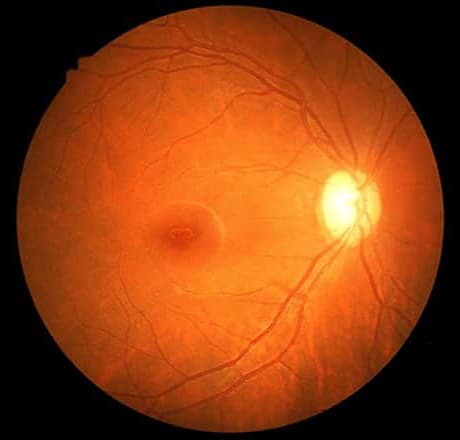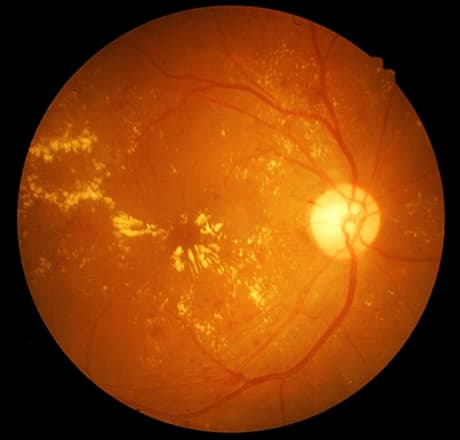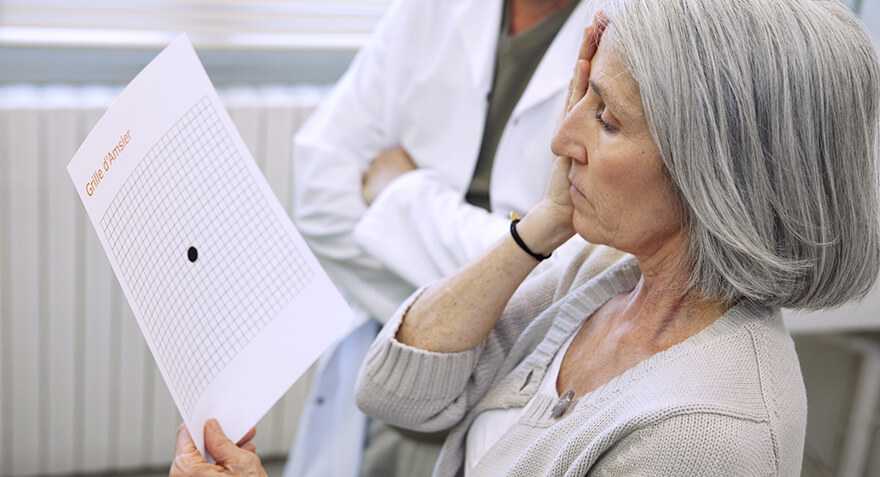What Is Macular Degeneration?
Age-related macular degeneration (AMD) is a problem with your retina. It happens when a part of the retina called the macula is damaged. With AMD you lose your central vision. You cannot see fine details, whether you are looking at something close or far. But your peripheral (side) vision will still be normal. For instance, imagine you are looking at a clock with hands. With AMD, you might see the clock’s numbers but not the hands. AMD is very common. It is a leading cause of vision loss in people 50 years or older.


Two types of AMD
Dry AMD
This form is quite common. About 80% (8 out of 10) of people who have AMD have the dry form. Dry AMD is when parts of the macula get thinner with age and tiny clumps of protein called drusen grow. You slowly lose central vision. There is no way to treat dry AMD yet.
Wet AMD
This form is less common but much more serious. Wet AMD is when new, abnormal blood vessels grow under the retina. These vessels may leak blood or other fluids, causing scarring of the macula. You lose vision faster with wet AMD than with dry AMD.
Many people don’t realize they have AMD until their vision is very blurry. This is why it is important to have regular visits to an ophthalmologist. He or she can look for early signs of AMD before you have any vision problems.
Who Is at Risk for AMD?
You are more likely to develop AMD if you:
- eat a diet high in saturated fat (found in foods like meat, butter, and cheese)
- are overweight
- smoke cigarettes
- are over 50 years old have hypertension (high blood pressure)
- have a family history of AMD
- Having heart disease is another risk factor for AMD, as is having high cholesterol levels. Caucasians (white people) also have an elevated risk of getting AMD
How is AMD Diagnosed and Treated?
During an eye exam, your ophthalmologist may ask you to look at an Amsler grid. This grid helps you notice any blurry, distorted, or blank spots in your field of vision. Your ophthalmologist will also look inside your eye through a special lens. He or she can see if there are changes in the retina and macula.

Your ophthalmologist will put dilating eye drops in your eye to widen your pupil. This allows him or her to look through a special lens at the inside of your eye.
Optical coherence tomography (OCT) is another way to look closely at the retina. A machine scans the retina and provides very detailed images of the retina and macula.
Optical coherence tomography angiography (OCTA) is another way to look closely at the blood vessels in and under the retina. This is like fluorescein angiography but does not use a dye.
Age-Related Macular Degeneration Treatment
Dry AMD treatment
Right now, there is no way to treat the dry form of AMD. However people with lots of drusen or serious vision loss might benefit from taking a certain combination of nutritional supplements.
A large study (AREDS and the later AREDS 2 study) found those people may slow their dry AMD by taking these vitamins and minerals daily:
- Vitamin C (500 mg)
- Vitamin E (400 IU)
- Lutein (10 mg)
- Zeaxanthin (2 mg)
- Zinc (80 mg)
- Copper (2 mg)
Your ophthalmologist can tell you if vitamins and minerals are recommended for your dry AMD, as not all forms will benefit from the AREDS supplements.
Eye-healthy foods
Dark leafy greens, yellow fruits and vegetables, fish, and a balanced, nutrient-rich diet have been shown beneficial for people with AMD.
Wet AMD treatment
To help treat wet AMD, there are medications called anti-VEGF drugs. Anti-VEGF treatment helps reduce the number of abnormal blood vessels in your retina. It also slows any leaking from blood vessels. This medicine is delivered to your eye through a very slender needle. Laser surgery may also be used to treat some types of wet AMD. Your eye surgeon shines a laser light beam on the abnormal blood vessels. This reduces the number of vessels and slows their leaking. Talk with your ophthalmologist about ways to treat your AMD.
Vitamins for AMD
People who have a certain form of age-related macular degeneration (AMD) may benefit from a specific mix of vitamins and minerals. Taking these nutritional supplements might help slow this eye disease. About 8 out of 10 people with AMD have the dry form. This condition is due to a breakdown or thinning of the macula. Dry AMD usually begins when tiny, yellow deposits called drusen form under the retina. Eventually, the macula may become thinner and stop working properly.
Many people with AMD have drusen. These alone do not cause vision loss. But when drusen grow in size or number, you are at risk for getting early or intermediate AMD. There are not always symptoms with these stages of AMD, though people with intermediate AMD might start to notice a blurred spot in their central vision.
Advanced AMD develops when cells in your macula begin to break down. This is when the blurred spot in your central vision starts getting bigger and darker. That is what robs you of your central vision.
Dry AMD and AREDS Vitamins
AREDS 2 (Age-Related Eye Disease Study 2) was a very large research study. It looked at taking vitamins and minerals daily for AMD. This study found that certain nutritional supplements could help some people who have a lot of drusen. These supplements may also help people who have lost a lot of vision in at least one eye from AMD.
Taking the following nutritional supplements every day may help these people lower their risk of getting late-stage or wet AMD:
- Vitamin C (500 mg)
- Vitamin E (400 IU)
- Lutein (10 mg)
- Zeaxanthin (2 mg)
- Zinc (80 mg)
- Copper (2 mg)
It is important to remember that nutritional supplements are not a cure for AMD, but they may help to slow the disease in some people with early- to mid-stage AMD.
Should you take nutritional supplements for AMD?
Talk with your ophthalmologist about whether nutritional supplements are recommended for you.
Here are some topics to discuss:
- Your chance of getting advanced AMD. Studies show that nutritional supplements might help people with early to intermediate AMD who are at risk for developing advanced AMD.
- Eye-healthy foods. Studies show that nutritional supplements alone are not enough to prevent or delay advanced AMD. You also should eat a healthy, balanced diet. This includes dark leafy greens (like spinach and kale) along with yellow, orange and other colorful fruits and vegetables.
- Benefits and risks of nutritional supplements. Taking nutritional supplements can be helpful, but there can be possible health risks. Talk with your ophthalmologist and primary care doctor about how the vitamins and minerals listed above might affect you.



